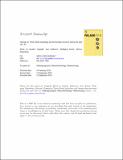Files in this item
Changes in Timor Strait hydrology and thermocline structure during the past 130 ka
Item metadata
| dc.contributor.author | Lo Giudice Cappelli, Elena | |
| dc.contributor.author | Holbourn, Ann | |
| dc.contributor.author | Kuhnt, Wolfgang | |
| dc.contributor.author | Regenberg, Marcus | |
| dc.date.accessioned | 2017-09-14T23:32:24Z | |
| dc.date.available | 2017-09-14T23:32:24Z | |
| dc.date.issued | 2016-11-15 | |
| dc.identifier | 245863398 | |
| dc.identifier | 3ca08f06-7342-413a-bbad-d8c2c3634c7f | |
| dc.identifier | 84991201132 | |
| dc.identifier | 000386404100009 | |
| dc.identifier.citation | Lo Giudice Cappelli , E , Holbourn , A , Kuhnt , W & Regenberg , M 2016 , ' Changes in Timor Strait hydrology and thermocline structure during the past 130 ka ' , Palaeogeography, Palaeoclimatology, Palaeoecology , vol. 462 , pp. 112-124 . https://doi.org/10.1016/j.palaeo.2016.09.010 | en |
| dc.identifier.issn | 0031-0182 | |
| dc.identifier.other | RIS: urn:094D58457A6C1E8E1EE5D32B123393DF | |
| dc.identifier.uri | https://hdl.handle.net/10023/11668 | |
| dc.description | Funding for this research was provided by the Marie Curie Action Plan, Seventh Framework Program (Grant no. 237922) and BMBF Grant 03G0185A (VITAL). | en |
| dc.description.abstract | Paleostudies of the Indonesian Throughflow (ITF) are largely based on temperature and salinity reconstructions of its near surface component, whereas the variability of its lower thermocline flow has rarely been investigated. We present a multi-proxy record of planktonic and benthic foraminiferal δ18O, Mg/Ca-derived surface and lower thermocline temperatures, X-ray fluorescence (XRF)-derived runoff and sediment winnowing for the past 130 ka in marine sediment core SO18471. Core SO18471, retrieved from a water depth of 485 m at the southern edge of the Timor Strait close to the Sahul Shelf, sits in a strategic position to reconstruct variations in both the ITF surface and lower thermocline flow as well as to investigate hydrological changes related to monsoon variability and shelf dynamics over time. Sediment winnowing demonstrates that the ITF thermocline flow intensified during MIS 5d-a and MIS 1. In contrast during MIS 5e, winnowing was reduced and terrigenous input increased suggesting intensification of the local wet monsoon and a weaker ITF. Lower thermocline warming during globally cold periods (MIS 4 – MIS 2) appears to be related to a weaker and contracted thermocline ITF and advection of warm and salty Indian Ocean waters. | |
| dc.format.extent | 13 | |
| dc.format.extent | 1084399 | |
| dc.language.iso | eng | |
| dc.relation.ispartof | Palaeogeography, Palaeoclimatology, Palaeoecology | en |
| dc.subject | Indonesian Throughflow | en |
| dc.subject | Timor Sea | en |
| dc.subject | Lower thermocline | en |
| dc.subject | Hoeglundina elegans Mg/Ca | en |
| dc.subject | X-ray fluorescence core scanning | en |
| dc.subject | G Geography (General) | en |
| dc.subject | GE Environmental Sciences | en |
| dc.subject | DAS | en |
| dc.subject | SDG 14 - Life Below Water | en |
| dc.subject.lcc | G1 | en |
| dc.subject.lcc | GE | en |
| dc.title | Changes in Timor Strait hydrology and thermocline structure during the past 130 ka | en |
| dc.type | Journal article | en |
| dc.contributor.institution | University of St Andrews. Geography & Sustainable Development | en |
| dc.contributor.institution | University of St Andrews. Earth and Environmental Sciences | en |
| dc.contributor.institution | University of St Andrews. Bell-Edwards Geographic Data Institute | en |
| dc.identifier.doi | https://doi.org/10.1016/j.palaeo.2016.09.010 | |
| dc.description.status | Peer reviewed | en |
| dc.date.embargoedUntil | 2017-09-14 |
This item appears in the following Collection(s)
Items in the St Andrews Research Repository are protected by copyright, with all rights reserved, unless otherwise indicated.

